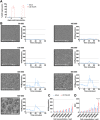Determination of CAR T cell metabolism in an optimized protocol
- PMID: 37409169
- PMCID: PMC10318902
- DOI: 10.3389/fbioe.2023.1207576
Determination of CAR T cell metabolism in an optimized protocol
Abstract
Adoptive transfer of T cells modified to express chimeric antigenic receptors (CAR) has emerged as a solution to cure refractory malignancies. However, although CAR T cell treatment of haematological cancers has now shown impressive improvement in outcome, solid tumours have been more challenging to control. The latter type is protected by a strong tumour microenvironment (TME) which might impact cellular therapeutic treatments. Indeed, the milieu around the tumour can become particularly inhibitory to T cells by directly affecting their metabolism. Consequently, the therapeutic cells become physically impeded before being able to attack the tumour. It is therefore extremely important to understand the mechanism behind this metabolic break in order to develop TME-resistant CAR T cells. Historically, the measurement of cellular metabolism has been performed at a low throughput which only permitted a limited number of measurements. However, this has been changed by the introduction of real-time technologies which have lately become more popular to study CAR T cell quality. Unfortunately, the published protocols lack uniformity and their interpretation become confusing. We herein tested the essential parameters to perform a metabolic study on CAR T cells and propose a check list of factors that should be set in order to draw sound conclusion.
Keywords: CAR T cell; Seahorse XF96; cancer therapy; immunotherapy; metabolim.
Copyright © 2023 Joaquina, Forcados, Caulier, Inderberg and Wälchli.
Conflict of interest statement
The authors declare that the research was conducted in the absence of any commercial or financial relationships that could be construed as a potential conflict of interest.
Figures





Similar articles
-
Chimeric Antigen Receptors for the Tumour Microenvironment.Adv Exp Med Biol. 2020;1263:117-143. doi: 10.1007/978-3-030-44518-8_8. Adv Exp Med Biol. 2020. PMID: 32588326 Review.
-
Metabolic and Mitochondrial Functioning in Chimeric Antigen Receptor (CAR)-T Cells.Cancers (Basel). 2021 Mar 11;13(6):1229. doi: 10.3390/cancers13061229. Cancers (Basel). 2021. PMID: 33799768 Free PMC article. Review.
-
Engineering chimeric antigen receptor T cells for solid tumour therapy.Clin Transl Med. 2022 Dec;12(12):e1141. doi: 10.1002/ctm2.1141. Clin Transl Med. 2022. PMID: 36495108 Free PMC article. Review.
-
Targeting of chimeric antigen receptor T cell metabolism to improve therapeutic outcomes.Front Immunol. 2023 Mar 14;14:1121565. doi: 10.3389/fimmu.2023.1121565. eCollection 2023. Front Immunol. 2023. PMID: 36999013 Free PMC article. Review.
-
Cutting-Edge CAR Engineering: Beyond T Cells.Biomedicines. 2022 Nov 24;10(12):3035. doi: 10.3390/biomedicines10123035. Biomedicines. 2022. PMID: 36551788 Free PMC article. Review.
References
-
- CAR T Cells (2023). CAR T cells: Engineering patients’ immune cells to treat their cancers. Available online: https://www.cancer.gov/about-cancer/treatment/research/car-t-cells (accessed on March 24, 2023).
LinkOut - more resources
Full Text Sources

